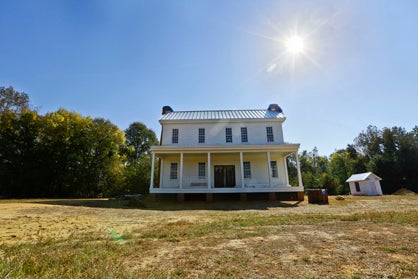Couple painstakingly moves and renovates historic home
Published 11:16 pm Thursday, December 18, 2014

The Molette House, built in 1865, has been moved twice in the past four years to save it from either being demolished or flooded.
David and Eleanor Cheatham are the proud owners of one of Dallas County’s oldest homes. By this spring, the couple expects to be residing in the 19th century Molette family plantation house they have been heavily involved in restoring over the past year. The process has had both ups and downs, but the Cheathams would not have wanted it any other way.
“Honestly, if we would have bought an old house that was fully restored that would have been very boring,” David said. “It’s all about the journey.”
Built in 1825, the Molette house has been in the family for nearly 200 years, or seven generations. Throughout that time, homeowners have not been the only ones doing the moving.
The house itself has been relocated twice in the past four years to ensure that it not be demolished or at risk to be destroyed by 100-year floodwaters, according to LG Squared, Inc., a residential architecture and consulting firm.

The Cheathams hope to move into the Molette house in 2015. Updates on the renovations can be followed on the Facebook page “The Molette House.”
For a majority of the years, the home sat at one undisclosed location in Dallas County until it was moved south of Orrville, on the edge of the Alabama River, to make room for a new home.
The parcel of land where the house sat was sold out of the family in 2008, and the new owner wanted to demolish the home to replace it with a hunting lodge.
Living in Atlanta, Ga., the Cheathams were in the midst of looking for an old home to restore and reside in at the time.
“We’ve just been fascinated with them,” David said. “It’s really hard to say why we love history, but it’s just the context of who we were, where we’ve been and how we got here that we find fascinating.”
While visiting Eleanor’s grandparents in Selma, the Cheathams learned that the family abode was scheduled to be demolished. It didn’t take long for the two to jump on the opportunity to own a house that has been in Eleanor’s family for centuries.
In October 2008, they graciously agreed to accept the home with the intent to move the building down the road about a mile, still near the river, and live in it right away.
Then unforeseeable circumstances placed the Cheathams’ plans on hold.
“Exactly as we got the house, the whole economy collapsed,” David said.
“We had two daughters, either in college or about to go to college. There wasn’t a whole lot of security, so basically we just said to move the house, put everything on hold and save our pennies with hope that one day we would be able to restore it and renovate it.”
During that time, the Dallas County Commission informed the Cheathams that the house was in a flood plain, and the Federal Emergency Management Agency would be forced to make numerous regulations relative to the house, such as requiring it be at least 10 feet off the ground, removing having any permanent siding from underneath and having to undergo engineering studies.
The expected overwhelming demands influenced the couple to have the 80-ton home transferred right outside of Orrville, which took place Nov. 6, 2013.
With the plantation dwelling lacking several windows, electricity, plumbing and more, the building was more like a “big tree house” than a home in its beginning stages.
Renovations included recreating windows and doors to match ones that were either too damaged to repair or missing; moving siding and repainting the house to match its original color; redoing interior wall paneling; and other steps to preserve or recreate the historic features of the home.
Additions included building a kitchen, dining room, laundry room, bathrooms and much more. Generally considered modern-day necessities, the features were once classified as luxuries not often added to a standard house.
About 80 percent of the construction work has been completed as of late November, David said.
“It’s been such an amazing transformation,” he said. “It’s kind of looked like some abandoned shack that you’d see somewhere in a bad part of town. But now that its been transformed, people love it and we love it.”
Per requests from family and friends, the homeowners designed a Facebook Page titled “The Molette House” that provides the public with frequent updates on the refurbishment process.
“It’s kind of like giving birth to a child, and seeing it grow and being amazed,” David said. “It really has grown beyond our wildest imagination and expectation when we look at how the house looks now compared to how it looked a year ago.”





